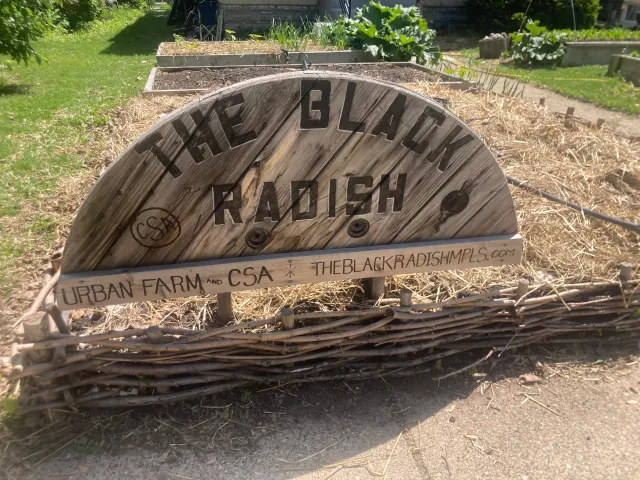The Sanneh Foundation is also partnering with Black Radish to double its space. Credit: Sheila Regan
…
Started by two artists, the Community Supported Agriculture project works with homeowners to create gardens filled with edible crops.
…

Two Minneapolis artists have taken their visual skills to the soil in the creation of Black Radish, an urban farm and Community Supported Agriculture (CSA) business that doubles as a landscaping firm. Located in the Standish-Ericsson neighborhood in South Minneapolis, Black Radish partners with neighbors to create vibrant gardens full of fresh locally grown foods.
They’re named after the fierce black radish vegetable, with an allusion to the black flag used by pirates, according to co-owner Jade Townsend. “We kind of take over people’s yards and do things a lot differently than a standard farm.”
Townsend is also an artist, with a background in drawing, sculpture and installation. His wife, Carrie Elizabeth Thompson, is a photographer. They met on Tinder about 10 years ago when Townsend was visiting from New York. Since 2018, they’ve been channeling their creative energy into growing things. Their main focus is on edible crops like rhubarb, garlic, tomatillos, komatsuna (Japanese mustard greens), tomatoes, lettuce, root vegetables, herbs and even mushrooms, and they also offer freshly cut flowers like dahlias and zinnias to their CSA members.
They’re both still practicing artists, but fine art has taken somewhat of a backseat to farming. “It’s more on the side, because this is a huge job,” Thompson said. “This is kind of like an art project for us. It’s like community art.”
Townsend sees a lot of overlap between farming and art making as well. “There’s this system of craft involved,” he said. “It’s like art on steroids.”
The couple decided to start an urban farm in part because they were sick of the vapidness of the art world. “We wanted to do something that made a difference in some capacity,” Townsend said.
Black Radish now spans 14 residential yards. In exchange for using a homeowner’s yard, the couple creates an aesthetically pleasing landscape featuring both produce and flowers such as marigolds and sunflowers. “Since it’s people’s yards, we try to make it look good,” Thompson said. “The idea isn’t just to grow food— it’s to create something beautiful.”

…
For some of the participating yards, Black Radish uses raised beds, while others have gardens planted directly in the ground. Black Radish also employs trellises for peas, cucumbers, beans and melons to climb over the course of the summer, creating lovely walkways in the yards.
CSA member Tiffany Enríquez, who lives a few blocks away from Thompson and Townsend and owns a second property in the neighborhood, is one of the neighbors on whose yard Black Radish operates.
…

…
For three years, Enríquez had done her own gardening before realizing it was a full-time job. She discovered Black Radish after participating in a community art project with the City of Lakes Community Land Trust. Enríquez had become a homeowner through the Land Trust, and through the organization participated in “This House is Not for Sale,” in collaboration with artists and poets.
“Basically they worked with homeowners who had bought foreclosed properties to sort of process that grief and what that means for a homeowner to move into a foreclosed home,” she said. She was partnered with artist Witt Siosoco and also met Townsend through the project.
Enríquez is delighted to have Black Radish create a garden on her property. “This is such a win for me,” she said.
Each week, the couple open up their backyard for the CSA pick-up for their members. It’s kind of like an art opening, Townsend said. They invite all 50 members to pick up the week’s harvest, and use Townsend’s whimsical chalkboard menu displays with drawings to organize the different items.
“It’s very much thought out in the same way you would have an exhibition or a show,” Townsend said. “You want them to have a certain experience.”
The project has also been one of community connection. “We introduce people and share recipes and different gardening techniques,” Townsend said.
Besides their regular members, Black Radish has also partnered with the Sanneh Foundation, through a grant from the Minneapolis Homegrown project. “We partner with them to purchase some of their CSAs, and we distribute those at our food distributions at Corcoran Park,” said Joe Walker, director of nutritional services with the Sanneh Foundation.
“Black Radish was a wonderful way for us to work with someone from the community and supply to the community, which is something we’re always trying to focus on,” he said. “It’s a really great way to be prescriptive about what our participants want in our food distributions, as well as bringing healthy, nutritious and locally grown produce. It’s just really been a win-win, and they’ve been fantastic. They’ve knocked it out of the park every year.”
The Sanneh Foundation is also partnering with Black Radish to double its land space. The foundation is acting as Black Radish’s fiscal sponsor for an online fundraising campaign, with the funds going toward what Black Radish needs for a down payment on 12,000 square feet of empty land in the neighborhood.
Black Radish is initially raising $65,000 for the down payment, with a long-term goal of $250,000 to purchase the land. For now, they’re holding off on becoming a nonprofit because, if they end up needing to apply for a USDA loan, they must do so under their current status as an LLC rather than a 501(c)(3). “We have a board, we have the paperwork in order, but we’re waiting until we secure the land,” Thompson said.
The new site could triple Black Radish’s production, because the new land is all in one location. Their current model that spans different yards requires workers to travel between locations, each with different shade levels and water systems. “Each yard has a different microclimate personality,” Thompson said. With the new land, they could reserve neighborhood yards for low-maintenance crops and dedicate the larger plot to plants requiring daily care.
Already, Black Radish has raised almost a third of the initial goal. The couple’s hope is to bring their artist-driven community farming project to the next level, blending artistic skill with agricultural know-how.




